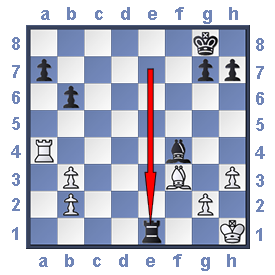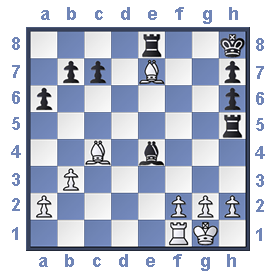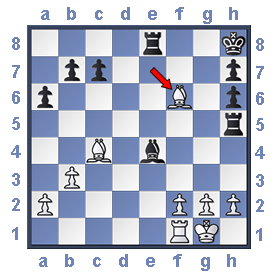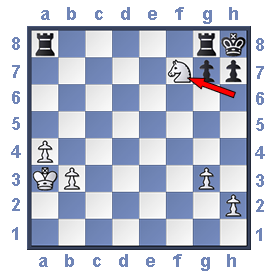| In this section we will show examples of how the mating patterns can be used in actual play. It will help you to understand these and other positions if you set them up on a chessboard when you are studying them. |
White to play. Queen and Bishop strike down the long diagonal.
1. QB7 checkmate. |
 |
 |
Black to Play. Black's Rook and Bishop are well placed. The Bishop covers the Kings 'flight' square on h2.
1.....Re1 checkmate. |
 |
 |
White to Play.
1. Bf6 checkmate. |
 |
 |
White to Play. The White Bishop covers the only flight square that the Black King has on g8.
Black has left many weak white squares and White takes advantage effectively with 1. Ng6 checkmate
|
 |
 |
Black to Play.
White has neglected the defence of his first rank and his King is vunerable.
1.....Qd1+ 2.Rxd1(forced) Rxd1 Checkmate |
 |
 |
White to Play
1. Nf6! this threatens Rxh7 mate next move and Black is totally lost. Black tries f2 but 2. Rxh7 checkmate. Try any move for Black but
|
 |
 |
White to Play. The b file is open and white takes full advantage of this.
1.Rxa7! Kxa7 (forced) 2.Ra1 checkmate.
|
 |
 |
White to Play. 1.Nh6++double check. Kh8 (if 1...Kf8 then 2. Qf7 checkmate).
2.Qg8+! Rxg8 (forced).
3.Nf7 checkmate !
|
 |
 |
| This checkmate commonly called 'smothered mate' was recorded as long ago as 1496 by a Spaniard called Lucena. |
White to Play.
1.Rh1+ Kg8
2.Rh8+! Kxh8
3Qh1+ Kg8
4. Qh7 checkmate.
All Black's moves were forced. |
 |
 |
A lot of the examples were forced wins for the attacking side. The defending side's moves were forced (i.e. the only move that could be made). Take for example the last position where white forces checkmate in 4 moves.
A lot of chess puzzles in newspapers, books and on computer programs give the initial position and state something like'Find the mate in 4 moves against any defence.' These are a good training area for the novice player and begin to familiarise you with solving problems over the chessboard, which will help your chess game improve. |

























 DISCLAIMER: The information given in this site is presented in good faith, but the site-author is human and does make mistakes! Should you find anything that you believe is in error please notify the Webmaster of your finding.
DISCLAIMER: The information given in this site is presented in good faith, but the site-author is human and does make mistakes! Should you find anything that you believe is in error please notify the Webmaster of your finding.